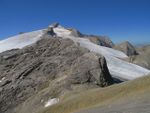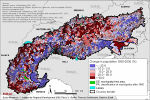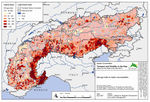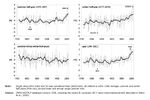Group G - Collaborative Climate Adaption Project: Difference between revisions
| Line 131: | Line 131: | ||
The picture below shows a simulation of the assumed situation in the year 2050 but also the change during the last 150 years. | The picture below shows a simulation of the assumed situation in the year 2050 but also the change during the last 150 years. | ||
| Line 152: | Line 140: | ||
</gallery> | </gallery> | ||
As already described in future the sensitive eco-system of the Alps is enormously affected by global warming, but we already can see the effects today. | As already described in future the sensitive eco-system of the Alps is enormously affected by global warming, but we already can see the effects today. | ||
| Line 160: | Line 147: | ||
But that’s not the only problem. Another is that rainfall-periods are turning into snowfall, so the melting ice will flow down all in one. That causes flood water perils which will affect the valley-regions where the melt-water is flowing into. So the increasing winter-precipitation is not just affecting the Alps itself but also the settlements in the river areas all over the country. | But that’s not the only problem. Another is that rainfall-periods are turning into snowfall, so the melting ice will flow down all in one. That causes flood water perils which will affect the valley-regions where the melt-water is flowing into. So the increasing winter-precipitation is not just affecting the Alps itself but also the settlements in the river areas all over the country. | ||
The rising temperature with the human activities increases the calamities possibilities in the Alpine region. Since in this region the global warming is faster as it recognized average warming the vulnerability is more sensitive. The more people change the land use, the more increase the emission. The weather extremes brings windstorms, flood, forest fires with caused effect on many areas.[http://news.xinhuanet.com/english2010/world/2010-06/18/c_13355860.htm] | |||
- ''Changing land use:'' more landslides, erosion are expected due to the more frequent heavy precipitation events. Also must be think of the damage of debris, which could be more serious problem for the cities. | |||
- ''Preception:'' changing seasonal precipitation, decreasing snow, rainfall increasing intensities. Effect on winter-tourism (less area for winter tourism), watter-supply, conflicts can be expected in the outside connected area of Alpine-region where droughts will be probable, and these events can be more frequent. | |||
- ''Melt–frozen effect:'' increase the risk of Rock-falls, serious problem for tourism (climbing) | |||
- ''Glaciers:'' glaciers falls, melt water outbrakes | |||
- ''Nature:'' heat waves bring more drought and wild fires with, that means effects on tourism but more in forestry (timber products). Forestry has been suffering from drought also the present time, and it has consequences on productivity, but it also can bring insect outbreaks. There could be effects on forest includes, in the biomass. Stroms affected big areas, has effect on monocultures,experiences shows that the conferous species are more sensitive for the storms as the deciduous species. It can expected that the Zonation will be changed. The vegetation (mainly the very –sensitive Alpine vegetation) will ‘move’ into higher zones upward and uphills. This fact endanger a lot of special and rare alpine-specific species (such as ''Leontopodium nivale''). | |||
[http://www.eea.europa.eu/publications/alps-climate-change-and-adaptation-2009] | |||
Illustration: Map/diagram/sketches/photos/background notes | Illustration: Map/diagram/sketches/photos/background notes | ||
Revision as of 00:39, 16 January 2013
Rationale: Why have you selected this case study area?
- Please summarise:- e.g. previous experience, is it your everyday environment?, specific vulnerability, previous research being done etc.
We selected The Alps because we believe that it is an emblem for the whole world. Europe has always been a step before the rest of the world, and somehow is an example in many of the paths that the rest of the world follows. The fact that the Alps are being affected so badly by the climate change is a wakeup call for everybody who has heard about climate change but does nothing to make things different.
During the semester the lecture of Carole Piton (Climate Change in the Alps – Thinking one step further!) also gave us encouragement to work with this area in this assignment. Besides the outlook in the Alp’s theme that we made for ourselves, was interesting for the three of us, and finally also by this reason we select this area.
Authors' perspectives
- What theoretical or professional perspective do you bring to the case study?
In the past years everyone can hear about the climate change and the terrible consequences which caused by it in our world. Mostly we are informed (when I write we, now I mean not professional experts) about this theme and its relevance incomplete by the press - as I experience it. When people hear this word “CLIMATE CHANGE” – came to their mind these kinds of expressions, such as: global warming, sea level rising, greenhouse gases, or the Netherlands. Of course it is good, but not enough in our century. In general how many people hear about the problems in Thailand, Alaska, Kenya or Saudi-Arabia and so on many places in the world which are touched by this global problem?! These previously mentioned places do not became known, or not enough; at least that way as we know about the problems in the Netherlands.
As young landscape architects/urban planners/architects we have also big responsibility to care about our environment surrounding by us, and using our knowledge in order to do something against climate change worldwide. We need to shape our world in the future by keeping in our mind the consequences of climate change, and see the exactly challenges which are going to wait for us to resolve them. We must work on this problem (more) deliberately.
One of the articles that I read about before we started to work with the area, and made me very motivated and interested, since this article from 2008 tells me in easy way that is actually happening right now in the Alps. As I am not expert of the theme, it was important to me understand easily, so as would be for many people who are not scientists. This article was about a discovery by a Swiss married couple in the Schnidejoch glacier, in Switzerland. They found ~4500 years old troves in this region; this fact scientific area, for the research worker was amazing finding since this was older as ‘Ötzi’, the ~3000 years old ice-frozen man.
Climatologist, Martin Grosjean from the University of Bern explains us what this fact means related to the climate change. (Need to be noticed that the Schnidejoch glacier is one of the most sensitive place in the Alps regarding the the temperature fluctuation, and climate change.) For him the finding at the Schnidejoch glacier is the evidence of the global warming. He says: “The skin is the most valuable trove. If the skin is exposed to weather, sunlight, wind, rain effects, almost immediately disintegrates. The fact of this leather is so undamaged, and well-conditioned, means up to the present time it was covered with ice, so the past 5000 years the glacier has never been lower, thinner than in 2003 and the following years.”[1][2][3]
Landscape and/or urban context
- Biogeography, land use patterns, cultural features, overall character, history and dynamics
The Alps were inhabited about 5000 years ago, when the first glaciers withdraw, and it became inhabitable. Nowadays they are one of the world most famous placer for tourism. They are the second favorite holyday place of Europe after the Mediterranean coast, and tourism represents 10 - 12% of the jobs there. The Alp area is also an important source of water for Europe. It provides safe drinking water as well as water to produce energy by hydropower, thermal power and biomass. It is also an important area of wood production. Forests cover 43% of the surface, and are used for construction and fuel. One quarter of the Alps surface is also potential agricultural land. Most of it is grassland and 12.6 %is arable land.
- ratio of green/blue and sealed/built-up areas
The sealed areas are not too high but have had an important growth. In Austria, for example, 5 % of the surface is used for roads or construction, 40% of this surface is sealed. About half of new residences in this country are for single-family. The built up areas in European countries have grown 20% in the last 20 years, while the population has grown only 6 % in this time. Construction is being limited already I some places like Switzerland.
Illustration: Map; sketches; short descriptive analyses
Cultural/social/political context
- Brief explanation of culture, political economy, legal framework
The Alps, heart of the European continent, is the home to diverse cultures. Nowadays eight states, France, Monaco, Italy, Switzerland, Liechtenstein, Austria, Germany and Slovenia inhabit this mountainous region. Many languages, a few Slav languages, German languages and Romance languages (French and Italian) and it´s dialects are being spoken around these lands. Some have been lost.
Most of the countries are wealthy ones, like Switzerland, and can afford to invest in ecological matters. Unlike poor countries, ecology should be a priority for them. It is an economic matter as well, and some things are already being done.
Some of these countries are members of the European community and have experience working together. Isolated measures for sustainable development are not an option. In spite of the cultural differences environmental problems are cross-borders. In this case, however, there is a growing desire for preservation within the society that is above the frontiers and makes the Alps a region with common issues and goals, which must act as one to face the climate problems. Like most of the world, population distribution in the Alpine region is changing. Urban population is growing while there is a rural exodus. Small communities in the mountains are reducing, except for the touristic ones, and people are moving to low-altitude locations and main urban centers. And when analyzing the Alpine region as a whole, there is also a change in the population distribution. The Central Alps are growing in population while Southwest Alps are being depopulated. This variation, in the population distribution, as well as the differences you can find in flora, fauna, climate, geology and culture along the Alps, makes it necessary to find special criteria for sustainable development to each individual case.
Illustration:
Bullet points, image, background notes
Local Climate
- What are the climatic conditions at present? Have there been extreme weather events in the near past?
- Which changes are expected? Is there any evidence?
The Alps is one of the biggest mountain range in Europe, and stretches at east from Slovenia, Austria through Italy, and Switzerland Liechtenstein westward Germany, France and to the Mediterranean Sea. The climate of the Alps is alpine, mountain climate. In generally, mountain climate characterises the low temperature and the high rainfall, and evidently under freezing point as snow, at the altitudes between 1000 m and 3000 m over the sea level. The mean precipitation of the area is between 2600 mm and 3600 mm per year. The ranges of the mountain has impact on the climate, from the foothills upwards the climate changes fast, so as the vegetation. It has different type of levels according to the vertical gradient, known as mountain sections/zoning. The temperature decreases with 0,5 Celsius per 100 m, and the precipitation is increases.
The Alps has 5 different climatic zones which are the following. The lowest zone is called colline zone, exits from ~500 m to ~1000 m. Between 800 m and 1700 m, is the montane zone. The third zone, sub-Alpine from 1600 m to 2400 m; followed by the Alpine zone from the edge of the tree line until the snow line, upward the glacial zone.
Generally the mountain regions are touched by more sensitively by the climate change; it is the same in the Alpine-region as well. During the past century the warming was twice compared to the global warming average. The reaction of the upland’s vegetation is that they move more upwards at the uphills (changes the previously mentioned vegetation zonation expected). Also a change in the forest includes. With the fact of that the temperature will increase, it means in the forestry of the alps that the forest cover will increase in the future, there can be changes in the biomassa, it has had already.
The case study of Ágnes Zólyomi [4] [5](Alteration of the alpine vegetation due to climate change: A case study in the Karwendel Alps, Tyrol, Austria) says us that the more than 1 Celsius warming in the region definitely had effect on vegetation. The range of the ‘Pinus mugo’ is increased more than 22000m2 and the average altitude border of this species is with 24 m upper as before in the last 60 years. Also the same can be observable with the grasses. On the other hand the range of Ericacae’ vegetation is unfortunately put down in the analyzed area; due to the invasion of the grasses and the Montain Pine. Many sensitive species are threatened with extinction in the future by the warming. If these alterations go further, changes can be expected also in zoology because of the changed feed sources (bilberry, butterflies which are connected to the alpine vegetation).
Between 1980 and 2006 more than 800 catastrophes were recorded and only 3% of it caused by earthquake, the other rest owing to extreme weather events caused many losses in the economy.[6]
- Switzerland) in an ecosystem model
Illustration: Table or time line
Analysis of vulnerability
- If you consider these potential changes - which aspects/functions of your case study would be affected?
Vulnerability of the Alps
According to the temperature-measures of Baden-Württemberg and Bavaria of the past 70 years, the global warming accounts for 0.7°C in comparison with southern Germany, where the warming is 1.2°C. In the months of December the average temperature increases to 2.7°C. While hot days in summer the glaciers can melt up to 10cm per day, which means that there are 3,5 million litre water rare released. Under the aspect of global warming the glaciers of the Alps lost 50% of their volume since 1850. In assumption of scientists from Zurich the Rhone-Glacier will be completely melted until the year 2100. In the region they probed the temperature will be increased up to 3.8°C.
The picture below shows a simulation of the assumed situation in the year 2050 but also the change during the last 150 years.
As already described in future the sensitive eco-system of the Alps is enormously affected by global warming, but we already can see the effects today.
For example landslides which are the results of ongoing rainfalls. Mountain-layers suck the excess of water and store it, when frost-period sets in, the water turns into ice, extends and slides down the mountain.
But that’s not the only problem. Another is that rainfall-periods are turning into snowfall, so the melting ice will flow down all in one. That causes flood water perils which will affect the valley-regions where the melt-water is flowing into. So the increasing winter-precipitation is not just affecting the Alps itself but also the settlements in the river areas all over the country.
The rising temperature with the human activities increases the calamities possibilities in the Alpine region. Since in this region the global warming is faster as it recognized average warming the vulnerability is more sensitive. The more people change the land use, the more increase the emission. The weather extremes brings windstorms, flood, forest fires with caused effect on many areas.[7]
- Changing land use: more landslides, erosion are expected due to the more frequent heavy precipitation events. Also must be think of the damage of debris, which could be more serious problem for the cities.
- Preception: changing seasonal precipitation, decreasing snow, rainfall increasing intensities. Effect on winter-tourism (less area for winter tourism), watter-supply, conflicts can be expected in the outside connected area of Alpine-region where droughts will be probable, and these events can be more frequent.
- Melt–frozen effect: increase the risk of Rock-falls, serious problem for tourism (climbing)
- Glaciers: glaciers falls, melt water outbrakes
- Nature: heat waves bring more drought and wild fires with, that means effects on tourism but more in forestry (timber products). Forestry has been suffering from drought also the present time, and it has consequences on productivity, but it also can bring insect outbreaks. There could be effects on forest includes, in the biomass. Stroms affected big areas, has effect on monocultures,experiences shows that the conferous species are more sensitive for the storms as the deciduous species. It can expected that the Zonation will be changed. The vegetation (mainly the very –sensitive Alpine vegetation) will ‘move’ into higher zones upward and uphills. This fact endanger a lot of special and rare alpine-specific species (such as Leontopodium nivale). [8]
Illustration: Map/diagram/sketches/photos/background notes
Proposals for Climate Change Adaption
- How could your case study area become more resilient to climate change?
- Which measures would need to be taken to adapt to the new situation?
- How could you assure sustainability of these measures?
- Please describe 2-3 measures
Proposals for Climate Change Mitigation
- Which measures would need to be taken to reduce greenhouse gas emissions and other drivers of climate change within your case study area?
- How could you assure sustainability of these measures?
- Please describe 2-3 measures
Your scenario
- How will this area look like in 2060?
- Please forecast one potential future development taking climate change into account
Illustration: Map/diagram/sketches photos and background notes
What can be generalized from this case study?
- Are there any important theoretical insights?
- Which research questions does it generate?
- Short statement plus background notes
Presentation Slides
- Addnewimagename.jpg
Slide One
- Addnewimagename.jpg
Slide Two
- Addnewimagename.jpg
Slide Three
Image Gallery
- Yourimage.jpg
your image text
- Yourimage.jpg
your image text
- Yourimage.jpg
your image text
- Yourimage.jpg
your image text
- Yourimage.jpg
your image text
- Yourimage.jpg
your image text
- Yourimage.jpg
your image text
- Yourimage.jpg
your image text
References
Please add literature, documentations and weblinks
About categories: You can add more categories with this tag: "", add your categories










